سواء كنت مدير مشروع، أو صاحب عمل، أو طالبًا منظمًا بجدية، فمن الأفضل أحيانًا أن تقوم ببعض العصف الذهني قبل تنفيذ فكرة ما. في الماضي، كان أعظم العقول في العالم يدوّنون أفكارهم على المناديل، أما اليوم فيستخدمون أدوات الرسم البياني.
ولكن بدلاً من الرسم التخطيطي في كراسة رسم تخطيطي قديم الطراز، يمكنك التعاون مع أشخاص آخرين باستخدام منصة رسم تخطيطي في الوقت الفعلي. برنامج الرسم التخطيطي يجعل من الممكن تبادل الأفكار حول المنتجات، ورسم مخطط تنظيمي، وتصور البيانات إما بمفردك أو مع مجموعة من الأشخاص. الحد الوحيد هو خيالك. ✨
إذا كنت تبحث عن أفضل أداة رسم تخطيطي، فربما تكون قد ضيقت نطاق بحثك إلى Lucidchart و Visio. تحظى هذه الخيارات بشعبية بين المستخدمين الأفراد والشركات المؤسسية، ولكن لا تزال لها إيجابياتها وسلبياتها.
في هذا الدليل، سنقدم لك نظرة عامة متعمقة عن الشد والجذب بين Visio و Lucidchart. تعرف على وظائفهما الرئيسية وأسعارهما وكيفية اختلاف النظامين الأساسيين للعثور على الخيار المناسب لحالتك.
وسنطلعك أيضًا على بديل قوي للوسيدكارت وفيزيو سيجعلك تقفز فرحًا. هيا بنا! 🕺
ما هو Lucidchart؟
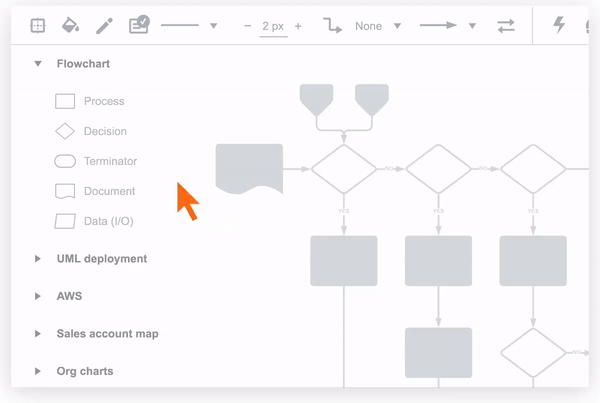
عبر لوسيدتشارتلوسيدشارت هو تطبيق تخطيطي يعتمد فقط على الويب. تم تصميم Lucidchart خصيصًا من أجل التعاون في الوقت الحقيقي والذي يسمح حتى لأكبر الفرق بتصور الأفكار المعقدة في مكان واحد. إذا كنت بحاجة إلى الحصول على فريق كبير في نفس الصفحة، فإن Lucidchart يسمح للجميع بالقفز وتعديل الرسم التخطيطي في نفس الوقت.
تستخدم الفرق لوسِدتشارت من أجل:
- بناء خرائط العمليات
- رسم خريطة لرحلات المستخدمين
- تنظيم الفرق
- تحديد تدفقات البيانات
- مخططات UML
تأتي أداة السحب والإفلات هذه مزودة أيضًا بتنسيق شرطي سهل الاستخدام حتى تتمكن من إنشاء رسومات معقدة بسرعة.
يحب مستخدمو نظامي ماك ولينكس Lucidchart لأنه يعمل في السحابة. يشتهر هذا البرنامج بتوافقه مع أي جهاز (بما في ذلك أجهزة أندرويد) أو نظام تشغيل.
ميزات Lucidchart
عندما تقارن بين Lucidchart وVisio، من المهم أن تقارن بين ما تحصل عليه مقابل المال. فيما يلي ميزات Lucidchart الأكثر إقناعاً.
التأليف المشترك عن بُعد
في حالة عدم وجود لوحة بيضاء حرفية، يعد Lucidchart خيارًا رائعًا للفرق البعيدة التي تحتاج إلى أداة السبورة البيضاء . ولكنها أيضًا خيار رائع للطلاب الذين يخططون لتقديم عرض تقديمي معًا، خاصةً إذا كنت لا ترغب في التنقل عبر الحرم الجامعي للاجتماع مع مجموعتك.
بغض النظر عن حالة الاستخدام الخاصة بك، فإن ميزة التأليف المشترك عن بُعد في Lucidchart تعني أن الجميع يتعاونون على نفس الرسم في وقت واحد. وهي تتضمن دردشة داخل المحرر حيث يشارك الجميع أفكارهم، بالإضافة إلى قسم للتعليقات حيث يمكنك الإشارة إلى أعضاء الفريق.
مكافأة:
/هريف/ /blog?p=69659 برنامج مخطط UML Diagram //%/href/
!
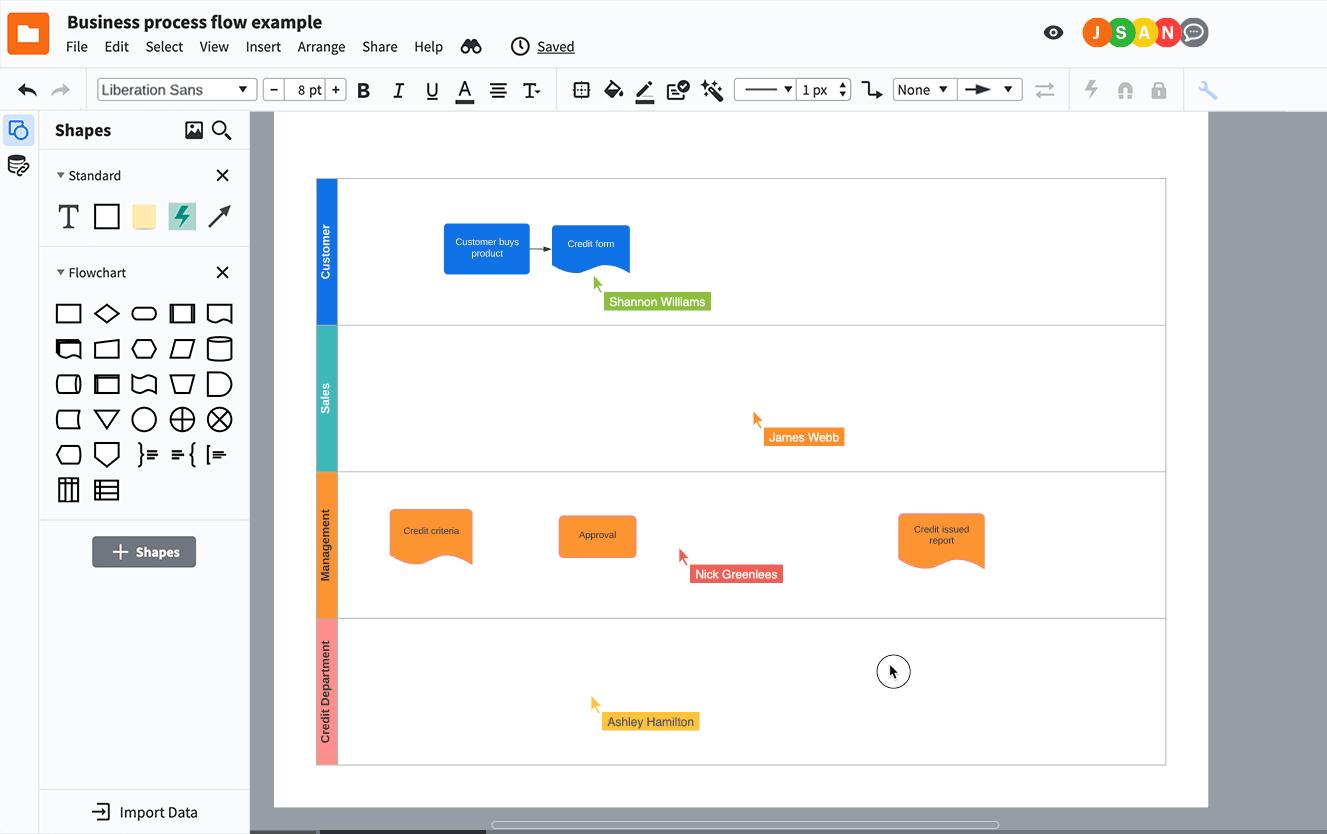
تبرز ميزة المؤشر التعاوني في Lucidchart كل شخص في الملف في الوقت الحقيقي
والأفضل من ذلك أن لوسِدشارت يحتوي أيضًا على مؤشرات تعاونية، بحيث يمكنك معرفة من هو موجود في لوسِدشارت.
وضع البيانات في سياقها
ليست هناك حاجة لنسخ ولصق البيانات في لوسِدتشارت. فهو يسمح لك بربط مصادر البيانات والمقاييس بالمنصة لبناء مخططات مليئة بالبيانات بسرعة.
ما عليك سوى إعداد ربط البيانات لتوصيل بياناتك يدوياً. أو، إذا كنت في عجلة من أمرك، اسمح لأداة التصور التلقائي في لوسِدكارت بتجميع كل شيء لك.
تخزين المستندات
قم بتوثيق معرفتك المؤسسية بدلاً من عزلها في صناديق البريد الإلكتروني لفريقك أو محركات الأقراص المحلية. تقوم لوسِدتشارت بتخزين المستندات وإتاحتها للجميع في بيئة سحابية في الوقت الفعلي. فكر في هذا كمكان مركزي واحد لإدارة جميع مخططاتك ومستنداتك.
لكن هذا لا يعني أنه يمكن للجميع الوصول إلى جميع ملفات لوسِد. يمكن للمسؤولين تخصيص الوصول إلى الحساب، لذلك إذا كنت بحاجة إلى الاحتفاظ بالمستوى التنفيذي جلسات السبورة البيضاء تحت الغلاف، هذا خيار.
التكاملات
مع Lucidchart، أنت حر في الالتزام بمجموعتك التقنية الحالية. تحتوي هذه المنصة على موصلات لـ
- مساحة عمل جوجل، بما في ذلك جوجل درايف
- مايكروسوفت
- أطلسيان
- كونفلوينس
- سلاك
يمكنك أيضاً تضمين مستندات لوسِدتشارت في التكنولوجيا التي يستخدمها فريقك بالفعل، أو استيراد الملفات إلى لوسِدتشارت لتسهيل التعاون.
لوسِدكال
هذه الميزة مخصصة أكثر للعاملين في مجال تكنولوجيا المعلومات والبيانات، ولكن إذا كنت أنت، فستحب لوسيدكال. إنه فرع من لوسيدكارت الذي تصور البيانات في AWS وMicrosoft Azure وGoogle Cloud Platform (GCP). إذا كنت بحاجة إلى مساعدة في حوكمة البيانات، فإن هذا يصور كل زاوية وركن في بيئتك السحابية.
تسعير ### لوسيدتشارت
- مجاني
- فردي: 7.95 دولار شهريًا لكل مستخدم
- الفريق: 9 دولارات شهريًا لكل مستخدم
- المؤسسات: اتصل لمعرفة الأسعار
ما هو فيزيو؟
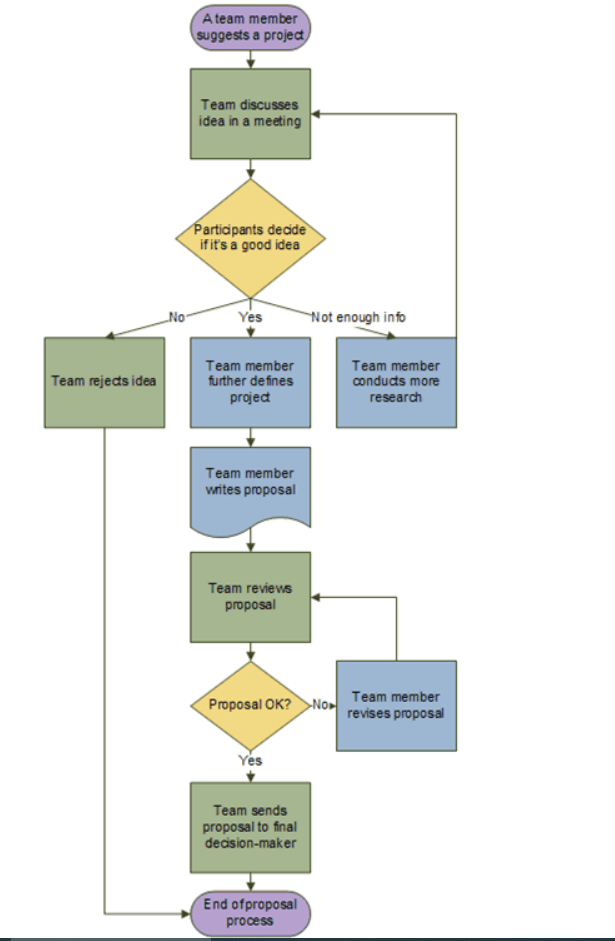
عبر فيزيومايكروسوفت فيزيو هو حل تخطيطي موجود منذ عام 1992. يمكنك شراء Visio كتطبيق مستقل، ولكنه يأتي أيضًا مع كل مايكروسوفت أوفيس 365 اشتراك تجاري.
عندما تقوم بالتسجيل في Visio، يمكنك الوصول الفوري إلى آلاف القوالب والأشكال القابلة للتخصيص. إذا كنت بحاجة إلى رسم تخطيطي ولكنك لا ترغب في إنشاء رسم تخطيطي خاص بك، ما عليك سوى تمرير قالب أو شكل Visio من المكتبة وستنطلق في السباق.
يتضمن Visio ميزات التعاون في الوقت الفعلي بين أعضاء الفريق المعتمدين. يتحكم المشرفون في من يرى ماذا، لذا فإن المنصة معروفة بكونها خاصة وآمنة.
ميزات Visio
يشترك Visio في الكثير من أوجه التشابه مع Lucidchart كبرنامج للمخططات الانسيابية، ولكن هناك العديد من الميزات التي تجعله متميزاً.
الشكل ومكتبة القوالب
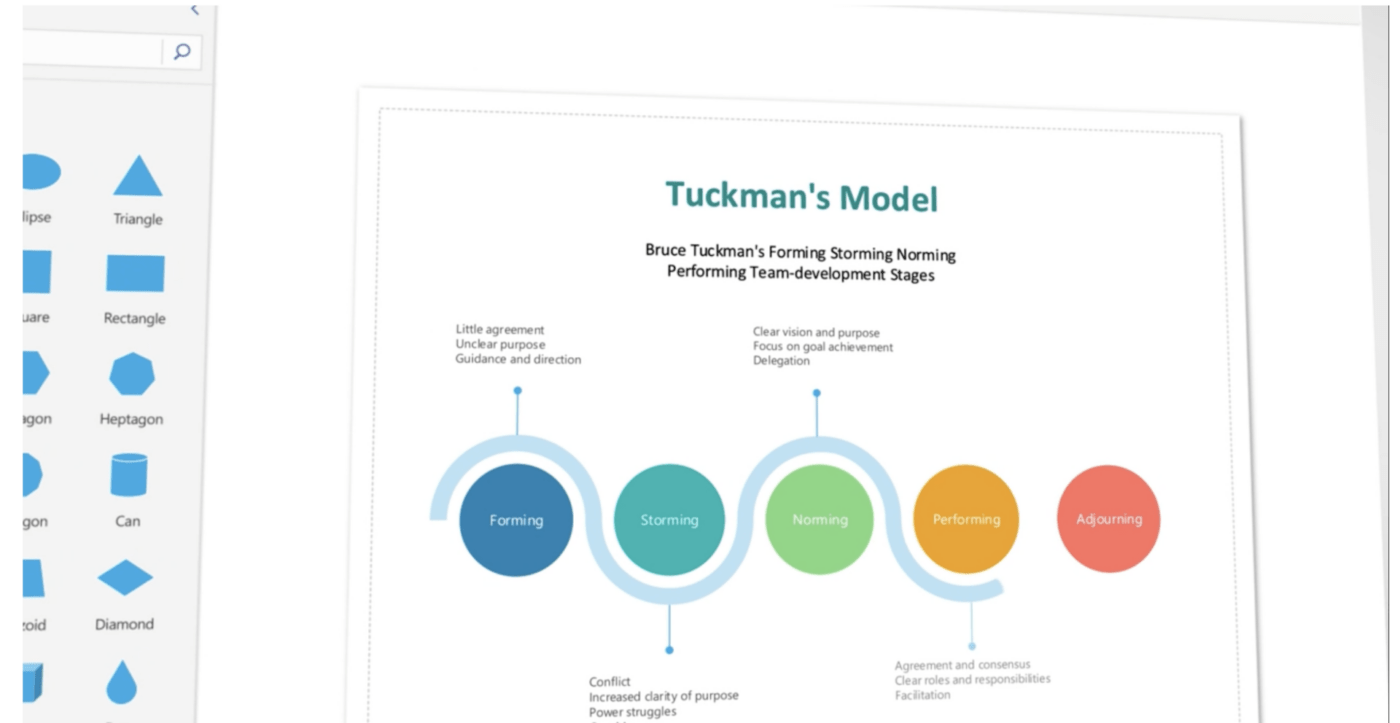
إنشاء مخططات انسيابية في Visio
لا تحتاج إلى مهارات في التصميم الجرافيكي هنا. يعد Visio رائعًا للمبتدئين والمستخدمين المتعددين لأنه يأتي محملاً مسبقًا بـ 250,000 شكل في مكتبته، بما في ذلك:
- مخططات انسيابية
- مخططات الشبكة
- المخططات التنظيمية
- مخططات الطوابق
- العمليات التجارية
ومع ذلك، ضع في اعتبارك أنك ستحتاج إلى اشتراك Visio مطور للوصول إلى الأشكال والقوالب المتميزة. قد تحتاج إلى دفع مبلغ إضافي إذا كنت تريد قوالب رسوم بيانية أكثر تعقيداً، مثل خرائط البنية السحابية أو العمليات التجارية.
مصادر البيانات
إذا كنت أحد عملاء Microsoft الحاليين، فمن السهل إدخال البيانات إلى Visio لرسم المخططات. فهو يقوم بنقل البيانات من Excel أو SQL Server، ولكن يمكنه أيضًا إنشاء رسم تخطيطي تلقائيًا وتوصيله مرة أخرى بملف Excel الخاص بك. عندما لا تفي ميزات الرسم التخطيطي في Excel بالغرض، فإن Visio يملأ الثغرات.
التكاملات
تهتم Microsoft بالحفاظ على الأشياء داخل بيئتها، ونحن نحترم ذلك. يمكن لمستخدمي Microsoft الحاليين أن يطمئنوا إلى أن ملفات Visio ستتصل بسلاسة بخصائص Microsoft الأخرى، بما في ذلك:
- Teams
- Power BI
- أتمتة الطاقة
- إكسل
- باور بوينت
- وورد
- ون درايف
- أزور
إمكانية الوصول
تحصل إعدادات إمكانية الوصول في Visio على درجة A+ منا. يأتي كل اشتراك في Visio مزوداً بميزات إمكانية الوصول، بما في ذلك:
- الراوي
- مدقق إمكانية الوصول
- مرئيات عالية التباين
إذا كانت شركتك ملتزمة بإمكانية الوصول والتضمين، فإن Visio بالتأكيد يجعل الرسوم البيانية في متناول الجميع.
تطبيق الويب وسطح المكتب
يقدم Visio تطبيق الويب لجميع المشتركين، على الرغم من أن الاشتراك الذي تمت ترقيته يتضمن أيضًا الوصول إلى إصدار سطح المكتب.
وبينما يمكن الوصول إلى إصدار الويب وتحديثه دائمًا، فإن إصدار سطح المكتب يقوم تلقائيًا بإنشاء مرئيات من مصادر البيانات مثل Excel أو Azure.
كما أنه مثالي للأجهزة التي تعمل باللمس إذا كنت ترغب في الرسم بإصبعك بدلاً من الفأرة. وإذا كنت ترغب في تحرير الرسوم البيانية دون اتصال بالإنترنت، فهذا متاح في إصدار سطح المكتب.
تسعير Visio
- الخطة 1: 5 دولارات شهريًا لكل مستخدم
- الخطة 2: 15 دولارًا شهريًا لكل مستخدم
Visio مقابل Lucidchart: مقارنة الميزات
في المعركة بين Lucidchart و Visio، من الصعب اختيار فائز واضح. كلتا المنصتين لها مزاياها وعيوبها، لذا فإن أفضل أداة رسم تخطيطي تعتمد على أهدافك وتفضيلاتك.
يسمح لك كل من Lucidchart و Visio بما يلي:
- إنشاء المخططات في واجهة مستخدم سهلة الاستخدام بالسحب والإفلات
- المشاركة في تأليف المخططات في الوقت الفعلي
- دمج البيانات من مصادر أخرى
- إدارة وصول المستخدم
مع ذلك، يختلفان في بعض المجالات الرئيسية.
- عمليات التكامل: يتكامل Lucidchart مع عدد قليل من تطبيقات الطرف الثالث، بينما تتكامل Microsoft فقط مع أدواتها المملوكة لها. لا بأس بذلك إذا كنت تستخدم مايكروسوفت بالفعل، ولكن إذا كنت تستخدم مزيجًا من التقنيات المختلفة، فقد يكون Visio أكثر تقييدًا
- سطح المكتب مقابل الويب: يفتخر Lucidchart بكونه تطبيقًا قائمًا على الويب، لذا يمكنك الوصول إليه على أي جهاز أو منصة. يمكنك الوصول إلى Visio في السحابة، لذا لا تتخلص من جهاز Macbook الخاص بك الآن. ولكن إذا كنت تريد الإصدار الأقوى لسطح المكتب من Visio، فستحتاج إلى جهاز كمبيوتر يعمل بنظام ويندوز
- إمكانية الوصول: يتمتع Lucidchart ببعض إمكانيات إمكانية الوصول، لكنه لا يضعها في المقدمة كما يفعل Visio. إذا كنت تعتمد على قارئ الشاشة أو أي تقنية مساعدة أخرى، فإن Visio أكثر توافقًا
- القوالب : يحتوي Visio على قوالب أكثر من Lucidchart، لكنك تحتاج إلى الترقية إلى الاشتراك الأغلى للوصول إليها جميعًا
- الأسعار : اشتراك Visio المستقل أرخص قليلاً من اشتراك Lucidchart، رغم أن كلاهما بأسعار معقولة جدًا. تكمن المشكلة في أن Visio يقدم ميزات متميزة حصرية، لذا قد تحتاج إلى دفع 15 دولارًا شهريًا للوصول إلى ما تحتاجه، وهو ضعف سعر Lucidchart. وبما أن Visio جزء من مجموعة مايكروسوفت، فقد يكون لديك بالفعل إمكانية الوصول إليه إذا كان لديك اشتراك تجاري في Microsoft 365
إذا لم تكن متأكدًا من أي من أدوات المخططات الانسيابية هذه تناسبك بشكل أفضل، إليك تصويتنا بناءً على الاحتياجات المختلفة.
| الحاجة | الفائز |
|---|---|
| إمكانية الوصول | Visio |
| تكاملات الطرف الثالث | لوسيدتشارت |
| تطبيق سطح المكتب | Visio |
| بساطة التسعير | لوسيدتشارت |
| متوافق مع مجموعة مايكروسوفت | Visio |
| التوافق مع مختلف الأجهزة | لوسيدتشارت |
تعرف على ClickUp: أفضل بديل لـ Lucidchart مقابل Visio
 img/
img/
اطلع على أكثر من 15 طريقة عرض في ClickUp لتخصيص سير عملك وفقًا لاحتياجاتك
انظر، نحن نعترف بأن لوسيدتشارت وفيزيو لهما إيجابياتهما. ولكن على الرغم من فائدة هاتين المنصتين إلا أنهما لا ترقى إلى مستوى منصتنا الإنتاجية التي تجمع بين جميع مخططاتك ومهامك ومحادثاتك وتقاريرك وقوالبك. 🕯️
ClickUp هي منصة فريدة من نوعها وشاملة تجمع كل بياناتك وأدوات التعاون في مكان واحد. لا مزيد من التبديل بين المنصات أو البرامج المختلفة - ما عليك سوى تسجيل الدخول إلى ClickUp للقيام بكل شيء.
بالتأكيد، لدينا مخططات تخطيطية، ولكن ClickUp أكثر بكثير من مجرد أداة رسم تخطيطي. إذا كنت تفضل أدوات سير عمل تخطيط العمليات القابلة للتخصيص، فلدينا هذه الأدوات. خرائط ذهنية ومخططات جانت؟ يحتوي ClickUp على مجموعة قوية من قوالب المخططات الجاهزة لتبسيط يوم عملك بجدية. 🤩
قم بالعصف الذهني بشكل أفضل باستخدام الخرائط الذهنية

قم بتخطيط وتنظيم المشاريع أو الأفكار أو المهام الحالية في ClickUp للحصول على مخطط تفصيلي مرئي مثالي برنامج رسم الخرائط الذهنية يجعل من الممكن تصور فكرة ما قبل تنفيذها فعليًا. هذا أمر لا بد منه للمشاريع أو العمليات المعقدة. ففي النهاية، أنت لا تريد أن تستثمر الكثير من الوقت في فكرة ما إذا كنت ستغير رأيك لاحقًا.
قبل أن تفعل أي شيء، قم برسم خريطة لها مع الخريطة الذهنية ClickUp . قم بربط الأفكار والمهام وسير العمل داخل لوحة معلومات ClickUp وتحويلها إلى مشاريع قابلة للتنفيذ ببضع نقرات فقط. كل شيء قابل للمشاركة مع فريقك أيضًا، حتى تتمكن من التوقف عن لعب دور علامة البريد الإلكتروني وتركيز طاقتك على الاهتمام بالأعمال.
خرائط ClickUp الذهنية إما أن تكون مستندة إلى المهام أو مستندة إلى العقد:
- مستندة إلى المهام: إذا كانت مهامك موصولة بالفعل في ClickUp وتحتاج فقط إلى تحديد سير العمل أو ترتيب الأشياء، فأنشئ خريطة ذهنية مستندة إلى المهام. يجعل ClickUp من السهل إضافة المهام وتعديلها وحذفها من الخريطة الذهنية دون الحاجة إلى مغادرة جلسة العصف الذهني
- مستند إلى العقدة: لست متأكدًا من أين تبدأ؟ لا مشكلة. قم بتوليد الأفكار كعقد في مستند العصف الذهني. عندما تكون راضيًا عن الخريطة الذهنية الخاصة بك، قم بتحويل العقد إلى مهام حتى يبدأ الجميع في العمل في أسرع وقت ممكن
تعاون بصريًا باستخدام اللوحات البيضاء
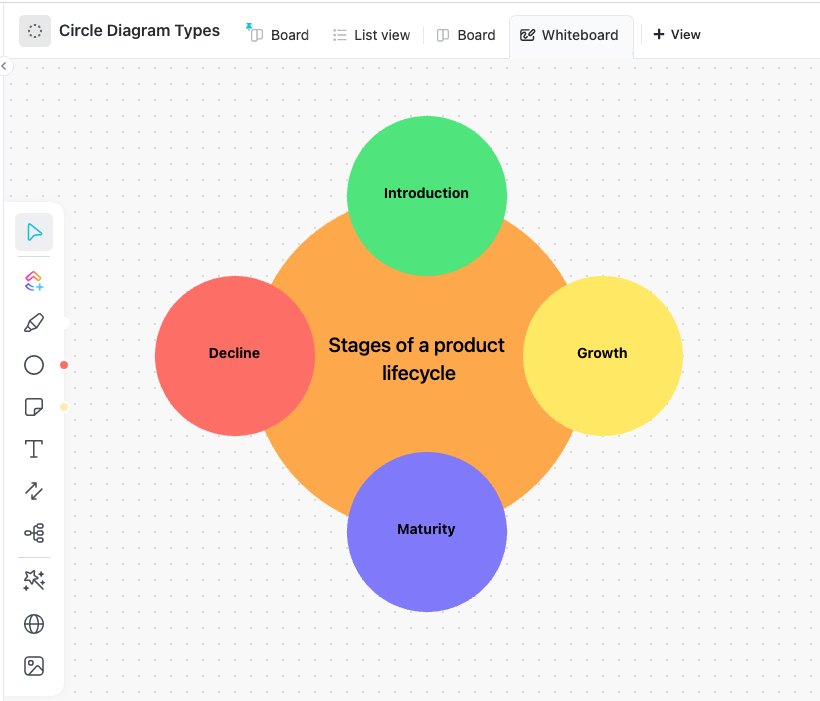
أضف الأشكال والنصوص والكائنات وحتى تحويل العناصر الموجودة في مخطط الدائرة إلى مهام باستخدام ClickUp Whiteboards ClickUp Whiteboards هي أداة تخطيطية قائمة على السحابة. مثل Lucidchart وVisio، تتيح لفريقك التعاون في الوقت الفعلي. أضف المزيد من السياق عن طريق تحميل الصور، أو إضافة روابط، أو توصيل الأصول إلى السبورات البيضاء.
استخدم السبورات البيضاء من أجل:
- جلسات العصف الذهني
- وضع الاستراتيجيات
- التأطير السلكي
- تخطيط البيانات
- بناء سير العمل
- تخطيط السياق
ClickUp هي اللوحة البيضاء الافتراضية الوحيدة في العالم التي تمنحك القدرة على إنشاء المخططات وتحويلها إلى مهام على نفس الشاشة. نحن هنا لتسريع عملية التفكير حتى تتمكن من الانتقال إلى الجزء الجيد: تنفيذ أفكارك الكبيرة. 💡
وفر الوقت باستخدام القوالب

اعرض مخطط عظم السمكة الخاص بك عن طريق تخصيص أحد قوالب ClickUp العديدة
لا نريد أن نتباهى بأنفسنا، ولكن ClickUp مشهور بالقوالب. بجدية. لدينا قالب لأي شيء تقريباً.
بالتأكيد، يمنحك Lucidchart و Visio قوالب للرسوم البيانية، ولكن هل لديهم أيضًا قوالب لإدارة الوكالات أو الموارد البشرية أو تخطيط تكنولوجيا المعلومات أو الجدولة؟ لدينا كل ذلك وأكثر. قوالب ClickUp اختصر الوقت الذي تقضيه في إنشاء المستندات وتنسيقها. باستخدام ClickUp، يمكنك وضع مخططاتك البيانية الرائعة والعودة بسرعة إلى العمل. ما رأيك في سهولة الاستخدام؟
أسعار ClickUp
- مجاني للأبد
- غير محدود: 5 دولارات شهريًا لكل مستخدم
- الشركات: 12 دولارًا شهريًا لكل مستخدم
- أعمال بلس: 19 دولارًا شهريًا لكل مستخدم
- المؤسسات: اتصل للحصول على الأسعار
اجمع كل شيء معًا في ClickUp
عندما يتعلق الأمر بـ Lucidchart مقابل Visio، فكلاهما خياران شائعان للرسم التخطيطي في الوقت الفعلي. ولكن حتى مع هذه المنصات، فأنت تقفز بين إدارة المهام البرامج، ومحادثات الفريق، والتوثيق. هذا يبدو محمومًا جدًا بالنسبة لنا.
أوقف هذا الجنون واجمع كل عملك (ونعني كله في مكان واحد مع ClickUp. وفّر الوقت مع إعداد بديهي يعمل بجد حتى لا تضطر إلى ذلك. 🌻
لست مقتنعًا؟ جربه بنفسك. أنشئ مساحة عمل ClickUp الآن -إنه مجاني إلى الأبد!

